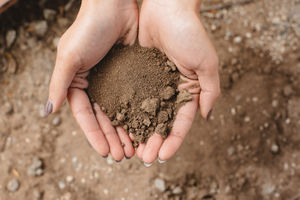Silt: Difference between revisions
No edit summary |
|||
| Line 6: | Line 6: | ||
==Formation== | ==Formation== | ||
Silt-producing mechanisms include frost shattering (Freeze-Thaw Weathering), comminution during transport, eolian abrasion, salt weathering, and glacial grinding. Windblown silt blankets the land in many parts of the world [2]. Large deposits of silt, such as this, are known as loess. Loess landscapes are usually a sign of past glacial activity, including areas such as the Great Plains. Silt can accumulate quickly in areas that lack vegetation, which can disrupt ecosystems. Silt also settles in still water, resulting in build ups like deltas. The main mineral origin of silt is quartz and feldspar. | |||
==Classification== | ==Classification== | ||
Revision as of 23:40, 8 May 2018
Definition

Silt is a granular sediment that can be transported and deposited by water, ice, and wind. Silt particles are larger than clay, but smaller than sand. To be classified as silt, a particle must be between .002 to .05 mm [1]. Similarly to clay, sand, and gravel, silt is found in soil. Silt can also occur as sediment mixed in suspension with water. Because of silt’s spherical shape, it retains a large amount of water. Silty soil is known to be more fertile than other soils, and many species of organisms thrive in it.
Formation
Silt-producing mechanisms include frost shattering (Freeze-Thaw Weathering), comminution during transport, eolian abrasion, salt weathering, and glacial grinding. Windblown silt blankets the land in many parts of the world [2]. Large deposits of silt, such as this, are known as loess. Loess landscapes are usually a sign of past glacial activity, including areas such as the Great Plains. Silt can accumulate quickly in areas that lack vegetation, which can disrupt ecosystems. Silt also settles in still water, resulting in build ups like deltas. The main mineral origin of silt is quartz and feldspar.
Classification
See also
- Clay
- Loam
- Founders of Soil Concepts
- Humus
- Microorganisms
- Pedogenesis
- Soil
- Soil Textures
- Soil Properties
- Jenny Equation
References
[1] National Geographic Society. “Silt.” National Geographic Society, 9 Oct. 2012, www.nationalgeographic.org/encyclopedia/silt/.
[2]
[3]
[4]
[5]
[6]
“Silt: Environmental Impact.” Rashid's Blog: An Educational Portal, 8 May 2016, rashidfaridi.com/2016/03/04/silt-environmental-impact/.